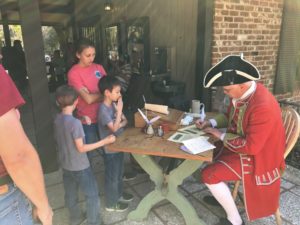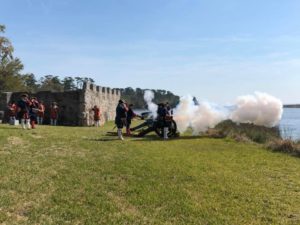
In February and March of 1736, the first colonists came to Frederica and started to build the town. Frederica was a military outpost, a fortified town on the southern frontier of the British colonies. The people of the town and the 42nd Regiment of Foot that was stationed here knew that the Spanish might attack from Florida at any time. Although Frederica is important in Georgia history for beating back the Spanish, the town itself only lasted 20 years before it was abandoned. Once the British achieved peace with Spain, the Regiment was withdrawn and there wasn’t enough commerce to support the tradespeople. Every year in March, Fort Frederica National Monument celebrates the founding of Frederica in a Colonial Day. This year Colonial Day was March 24.
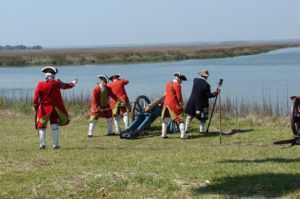
Most Saturdays from January through March we had five volunteers in a “village” doing living history. I talked about textiles, Tom did blacksmithing, Phil did tools, Gail did food preservation and cooking, and Marcia made candles. But when we celebrated 282nd anniversary of the founding of Frederica, we had closer to 30 living historians talking to guests and demonstrating.
I wrote a post about Colonial Day last year and there were many similarities to this year. The Spanish from Castillo de San Marco came again and fired their cannon. Tom, once again, was part of the Heron Company of the 42nd Regiment of Foot. They did musket demonstrations and cannon firing. Jim Sawgrass was just as popular as last year with his depiction of Native American life as Chief Tomochichi.
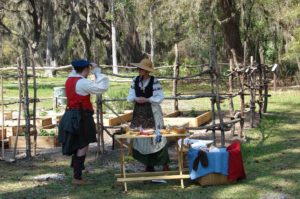
But there were some significant differences with last year. More of the living historians were people from Fort Frederica. Each of us had our own tent and our own talk. Our programs are definitely more in-depth than they were last year. Marcia has taken the candle making to a whole new level. Denise has an extensive set-up for cloth dying and wore an authentic looking Salzburger outfit. My textile program is very detailed and I had the weaving component set up for the founding of Frederica. We had a few additional areas including a colonial games area for children and a recruiting station for soldiers to enlist.
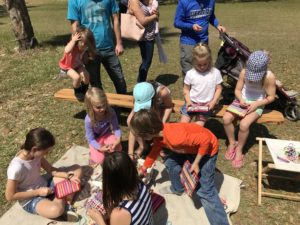
The biggest difference from last year was the number of people who attended. We easily had 200 more people than attended last year. Which meant that, even though we had people to give us breaks, I had a five minute lunch and spent the rest of the day talking to people. I always had a crowd trying their hand at weaving a hot pad and about 20 kids and adults took time to complete one.
I had one special visitor who spent over an hour with me. Elias is a five-year old who was fascinated by my weasel. Not only did he want to know everything about how it worked, he loved explaining it to others. He listened to my talk a few times and then was able to
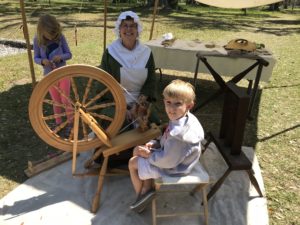
give it himself, including singing the “Pop goes the Weasel” song. He really wanted to do the winding of the yarn himself, but I didn’t have a full bobbin yet and was reluctant. Elias told me that was okay – he would just watch me spin. He pulled up a camp chair and sat right in front of the wheel watching. It didn’t take very long for me to decide I had enough yarn to let him use the weasel. But Elias wasn’t selfish about it: he organized other children in a line so they could do the “pop” too. He did it first, but he made sure everyone who wanted to had a turn. Elias is either going to be a great manager or a textile artist.

We had a wonderful day celebrating the founding of Frederica. The only problem – I was so busy I didn’t get many pictures! So I borrowed a few from the other people who also got only a few shots of their areas. A great problem to have!

